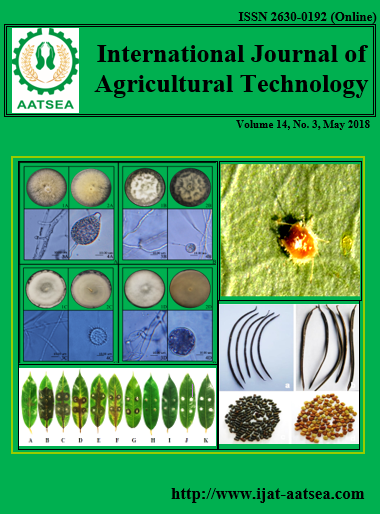The Utilization of Spent Oyster Mushroom Substrates Into Compost and Its Effect on the Growth of Indian Mustard (Brassica juncea (L.) Czern.) in the Screenhouse
Main Article Content
Abstract
Spent mushroom substrate is a byproduct of mushroom industries that created various environmental problems.The utilize spent oyster mushroom substrate which mainly contains sawdust to be made as organic fertilizer was investigated. Fresh sawdust, sawdust from the spent oyster mushroom substrate and cow manure was composted and its effects on the growth of Indian mustard (Brassica juncea) were determined. The composition of compost substrate was sawdust (L1) or spent oyster mushroom substrate (L2) in combination with cow manure ratio of 100% (P1), 75% (P2), 50% (P3), 25% (P4), and 0% (P5). Composting parameters were pH, temperature, water content, organic C, total N, P, K content, and C/N ratio, while the plant growth parameter was the plant height, total leaves, and wet weight per plant. The study showed that the best produced compost was from the combination of sawdust or spent oyster mushroom substrate and cow manure (L1P2 and L2P2). It is suggested that a problem for organic waste utilization into compost can be solved.The highest plant height, total leaves, and wet weight per plant of Indian mustard were obtained from the plant fertilized with the compost from cow manure alone, which were not significantly different with that 25% sawdust and 75% cow manure (L1P2) or 25% spent oyster mushroom substrate and 75% cow manure (L2P2).
Article Details

This work is licensed under a Creative Commons Attribution-NonCommercial-NoDerivatives 4.0 International License.
References
Ashrafi, R., Rahman, M. M., Jahiruddin, M. and Mian, M. H. (2015). Quality assessment of compost prepared from spent mushroom substrate. Progressive Agriculture 25:1-8.
BPS-Statistics Indonesia (2017). Statistics of Seasonal Vegetable and Fruit Plants Indonesia 101 p.
Choudhury, M. B. K., Rahman, T., Kakon, A. J., Hoque, N., Akhtaruzzaman, M., Begum, M. M., Choudhuri, M. S. K. and Hossain, M. S. (2013). Effects of Pleurotus ostreatus on blood pressure and glycemic status of hypertensive diabetic male volunteers. Bangladesh Journal of Medical Biochemistry 6:5-10.
Day, M. and Shaw, K. (2001). Biological, chemical, and physical processes of composting. In: Stoffella, P. J. and Kahn, B. A. (Eds.), Compost Utilization in Horticultural Cropping Systems. Boca Raton, FL: Lewis Publishers. pp. 17-50.
Djaja, W., Suwardi, N. K., dan L. B. Salman, L. B. (2003). Research Report: Effect of Ratio of Milk Cow Dung and Sawdust on Compost Quality. Faculty of Husbandry, Padjadjaran University, Bandung, 6 p.
Eiland, F., Klamer, M., Lind, A. M., Leth, M., and Baath, E. (2001). Influence of initial C/N ratio on chemical and microbial composition during long term composting of straw. Microbial Ecology 41:272-280.
Febriansyah. (2009). The Assessment of C/N Ratio of Sengon (Albasia fucata) Sawdust on White Oyster Mushroom Production. (Undergraduate Thesis), Brawijaya University,. Malang.
Gichon, Y. (2006). Compost Standard in the United States Department of Agriculture's National Organic Program Regulation: Implications and Limitations (Doctoral Dissertation), University of Florida.
Gümüş, İ. and Şeker, C. (2017). Effects of spent mushroom compost application on the physicochemical properties of a degraded soil. Solid Earth 8:1153-1160.
Haygreen, J. G and Bowyer, J. L. (1989). Forest Products and Wood Science, 2nd ed. Iowa State University Press. 500 p.
Isroi (2008). Compost. Indonesian Biotechnology Research Institute for Estate Crops, Bogor, 26 p.
Medina, E., Paredes, C., Pérez-Murcia, M. D., Bustamante, M. A. and Moral, R. (2009). Spent mushroom substrates as component of growing media for germination and growth of horticultural plants. Bioresource Technology 100:4227-4232.
Medina, E., Paredes, C., Bustamante, M. A., Moral, R. and Moreno-Caselles, J. (2012). Relationships between soil physico-chemical, chemical and biological properties in a soil amended with spent mushroom substrate. Geoderma 173:152-161.
Meng, X., Liu, B., Xi, C., Luo, X., Yuan, X., Wang, X., Zhu, W., Wang, H. and Cui, Z. (2018). Effect of pig manure on the chemical composition and microbial diversity during co-composting with spent mushroom substrate and rice husks. Bioresource Technology 251:22-30.
Michel, F. C. Jr., Pecchia, J. A., Rigot, J. and Keener, H. M. (2004). Mass and nutrient losses during the composting of dairy manure amended with sawdust and straw. Compost Science and Utilization 12:323-334.
Pandebesie (2012). Effect of the addition of rice husk on the domestic waste composting process. Jurnal Lingkungan Tropis 6:31-40.
Phan, C. W. and Sabaratnam, V. (2012). Potential uses of spent mushroom substrate and its associated lignocellulosic enzymes. Applied Microbiology and Biotechnology 96:863-873.
Priadi, D., Arfani, A., Saskiawan, I., and Mulyaningsih, E. S. (2016). Use of grass and spent mushroom compost as a growing medium of local tomato (Lycopersicon esculentum Miller) seedling in the nursery. Agrivita 38:242-250.
Raj, A., Jhariya, M. K. and Toppo, P. (2014). Cow dung for eco-friendly and sustainable productive farming. Environmental Science 3:201-202.
Raviv, M., Medina, S., Krasnovsky, A. and Ziadna, H. (2002). Conserving nitrogen during composting. Biocycle 43:48-48.
Saskiawan, I., Munir, M., and Achmadi, S. S. (2016). Optimization of exopolysaccharide production from Pleurotus ostreatus growth on liquid medium and analysis of its antioxidant and antimicrobial activity. Berita Biologi 15:133-140.
Schippers, R. R. and Mnzava, R. R. (2004). Brassica juncea in Vegetables. In Grubben et al. (Eds.), Plant Tropical Resources of Tropical Africa (PROTA 2), PROTA Foundation, Wageningen, Netherlands. 667 p.
Sevindrajuta (2012). Effect of Cow Manures on the Chemical Properties of Inceptisol and Growth of Amaranthus tricolor L.). (Undergraduate Thesia). Muhammadiyah University.
Sulaeman, D. (2011). Effect of Compost Made From Waste of White Oyster Mushrooms (Pleurotus ostreatus Jacquin) Baglog on The Physical Properties of Soil and The Growth of Yellow Passion Fruit Seedling (Passiflora edulis var. Flavicarpa Degner). (Undergraduate Thesis). Bogor Agricultural University.
Van Fan, Y., Lee, C. T., Leow, C. W., Chua, L. S. and Sarmidi, M. R. (2016). Physico-chemical and biological changes during co-composting of model kitchen waste, rice bran and dried leaves with different microbial inoculants. Malaysian Journal of Analytical Sciences 20:1447-1457.
Widarti, B. N., Wardhini, W. K. and Sarwono, E. (2015). Effect of composting material C/N ratio on compost production from cabbage and banana peel. Jurnal Integrasi Proses Untirta Banten 5:75-80.


